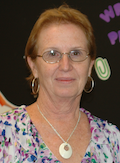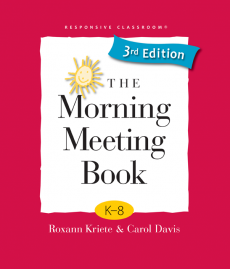An Even Better Morning Meeting Book
The Morning Meeting Book, K-8, 3rd edition
By Roxanne Kriete and Carol Davis
(Northeast Foundation for Children, 2014 – Learn more)

One of my most used and shared resources has been The Morning Meeting Book, K-8 by Roxanne Kriete and Carol Davis. In fact, I have two copies – one for home reference and one for school. Whenever a new teacher joined my team, it was the book I recommended and often shared –so long as it was returned!
When the folks at the Northeast Foundation for Children (Responsive Classroom) announced that there was a new edition coming, I wondered, “How can you make a such a great thing better?” Well, Roxanne Kriete and Carol Davis did it! The third edition of The Morning Meeting Book, K-8 follows the same format as the previous editions, but has been modified to reflect the Common Core Standards and 21st Century Skills.

Making connections
In the introduction, Roxanne Kriete tells her own “Chicken Soup” story about a student’s words that left an imprint in her mind and soul. “I will always remember how you said, ‘Hi, Sue’ as I walked into eighth period. It made me feel like it really mattered that I came.” Twenty years later, Ms. Kriete can still remember how those two simple words impacted a student’s life.
That’s what Morning Meeting is all about. It’s about making connections and acknowledgements, about establishing a community whose members take care of each other and help each other. It’s about establishing a routine that students can depend upon in their busy and oftentimes unsettling lives.
Teachers who practice the tenants of Morning Meeting in their classrooms attest that there are fewer discipline problems, higher achievement, and a classroom environment of respect.
What’s inside the new edition
The updated edition of The Morning Meeting Book, K-8 reflects current educational best practices based on research and the Common Core Standards. For example, educators and researchers have recognized the importance of dialogue in promoting academic growth. In order for students to engage in meaningful and productive academic conversation, or accountable talk, they need modeling and practice, which is a key element of Morning Meeting.
Teachers often are concerned about having enough time to address the standards. The ability to collaborate, problem solve, build upon others’ ideas and evaluate information in various forms are some of the requirements of the Common Core. The new Morning Meeting book addresses these Common Core expectations and the 20-minute format that it describes fits into any schedule. What a unique and fun way to sneak in learning from the moment students begin their daily routine. When all the components of Morning Meeting are woven together, it becomes an exquisite tapestry of caring, trust and respect.
Reading the book is a pleasure. You can choose to read the book chapter by chapter or select the sections that meet your current needs. Each section begins with an overview, an anecdotal story, “Purposes and Reflections,” “Getting Started” (the how section of the chapter), “Fine Tunings”(the question and answer section), and directions on how to use the suggested activities. (A side note: the print size in the book is “easy on your eyes”).
The Morning Meeting components
Each component of Morning Meeting is addressed in the book, with lots of ideas and ways to incorporate them into your current curriculum.
- Greeting: A Friendly and Respectful Salute
- Sharing: the Art and Skill of Conversation
- Group Activity: Building Whole-Class Identify
- Morning Message: A Letter to the Class
Greeting: For example, if your children are studying place value, “What’s Your Place Value?” (p. 83) reinforces place values. Give each student an index card or slip of paper with a three or four digit number on it. Choose a number from zero through nine and say, for example, “Anyone who has a four in the hundreds place, come to the center to meet and greet.” Students who fit that description come to the center of the circle, greet each other with a friendly handshake and a Good Morning greeting and return to their spots.
Sharing: I love using the Inside-Outside Circles activity (p. 124). It’s fun to watch students share what they have learned in school. The kids count off by twos. The Ones form an inner circle and face out. The Twos form an outer circle and face in so the circles are facing each other. The students are given a topic to discuss, such as recycling, and they have one minute to share with their partners. After one minute, the outside circle moves one person to the right while the inside circle stays in place and everyone shares with a new partner.
Group Activity: Here’s one – Mystery Word (p.162). A vocabulary word will be taped on a student’s back. That student is “it.” Her/his job is to guess the word using clues from classmates. He/she moves slowly around the inside of the circle, back turned to her classmates so they can see the word. They offer clues in the form of sentences that could include the word. For example, if the word is extinct, a clue might be, “If the ice cap keeps melting, polar bears might be blank.”
Morning Message: The purpose of this component is to welcome and greet students and get them excited about the day. Your objectives are imbedded into this valuable section. Morning Meeting messages can focus on any aspect of the curriculum, survey the students to gather data to form a line plot (p. 173), practice how to use context clues by “sneaking in” new vocabulary words into a message (p. 172), or post a math problem about a topic the students are excited about such as a class trip or concert (p. 178).
Routine respect
Our students need a sense of routine in their sometimes challenging, unpredictable lives. They also need the chance to be recognized, listened to respectfully, and valued for who they are. Morning Meeting is a powerful tool that meets those needs and helps to build a positive classroom culture.
I am always impressed by the quality of books published by the Northeast Foundation for Children. The third edition of The Morning Meeting Book, K-8 is a well researched, easy to read, and ready to apply guide to the Responsive Classroom philosophy and a perfect addition to any teacher’s bookcase. If you are already using Morning Meeting in your classroom, this new edition is well worth the additional investment.
And if you’re new to the Morning Meeting concept, read this book and you will learn some secrets that will help you connect to your students and accelerate their learning. It is an investment in children that is repaid many times!
Listen to a webinar discussing the new 3rd edition here.
Linda Biondi is a fourth grade teacher at Pond Road Middle School in Robbinsville, NJ, and a long-time Morning Meeting practitioner. She’s also the recipient of several educational grants, a Teacher Consultant with the National Writing Project and a participant on the NJ Department of Education Teacher Advisory Panel.

































